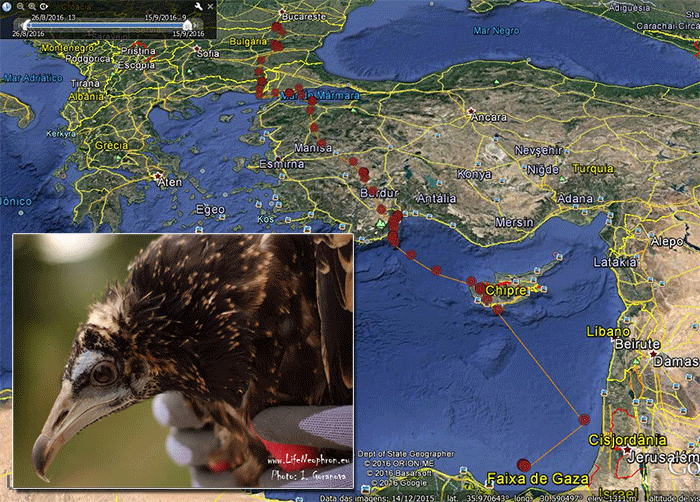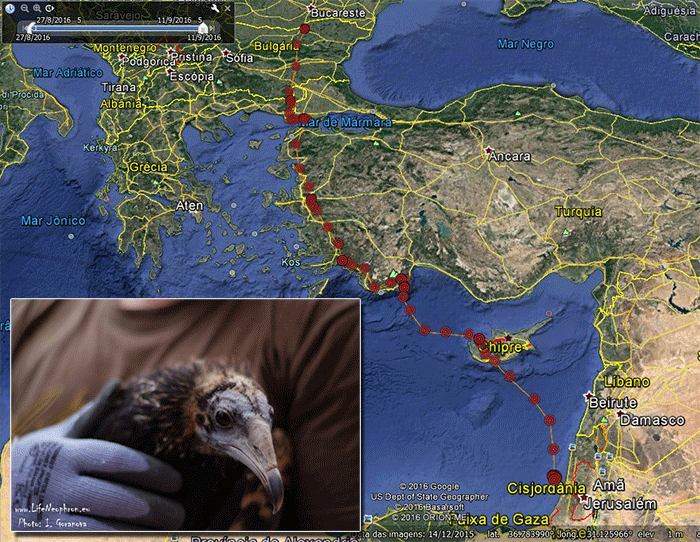Tagged Egyptian Vultures drown crossing the Med
When Regina, and then Lom – two of the three captive bred Egyptian Vultures released this year in Bulgaria – crossed from Turkey to Cyprus on their migration south, our hearts sunk. We knew already that about 70% of all tagged wild nestlings from the Balkans ended up drowning in the Med in their first migratory journey, and 3 of the 6 Egyptian vultures the VCF and CERM released last year in southern Italy also did not make it to the southern shores of the Med, falling into the sea.
We were hoping that Regina – the first bird to migrate, and then Lom – would follow the Turkish coast, but she unfortunately flew from Antalya to Cyprus on the 8th of September. After roosting on the western coast of Cyprus, she left her night perch quite early, between 6:00 and 7:00, and continued her migration south entering again into the sea through Akrotiri Peninsula at 10:00 – from there the distance to the nearest coast is 240 km. For 6 hours she flew over 190 km and at 16:00 she was only some 50 km from the Lebanese coast, but rather than flying east, she continued to fly over the sea some more 130 km in a southwestern direction and finally fell into the water, probably exhausted, at 20:00, just 25 km from the coast of Tel Aviv...

During her migration Regina flew over 1,500 km during 8 days, averaging ca. 200 km per day. She flew over 500 km over open sea, where she died.
Interestingly, her brother Lom followed almost exactly in her footsteps, a few days later. Unlike Regina, he had crossed the Marmara sea through the Marmara islands – and not through the Dardanelles, and migrated through Central Anatolia rather than following the coast. On the 13th September Lom entered into the sea from the same place (Adrasan) that Regina used, reaching the western coast of Cyprus, and the next day he flew south, almost reaching the Israeli coast, but then veered southwest and drowned off Egypt.
It is interesting that in Turkey, just before entering into the sea, both birds have made an effort to continue along the coast flying some 15 km in north-eastern direction, but unfortunately both finally quit this 'idea' and returned to Adrasan before reaching Antalya. The coast at that spot is quite narrow, with steep mountains falling into the sea, and the beach area quietly densely built with touristic resorts, so maybe this deterred the birds from continuing.

It is also interesting that both birds veered off the eastern Mediterranean coast when they were quite close, instead continuing over the open sea – was it winds, or disturbance?
These tragic deaths are really puzzling- Regina and Lom were certainly fit and well fed – in fact they flew long distances every day. Both birds flew over the emblematic Egyptian Vulturte sites in Bulgaria (Mazdharovo - Eastern Rhodopes) and Greece (Dadia - Thrace), when there were still wild birds present. Thus, the lack of potential experienced birds to guide the captive bred individuals along the flyway is also not an issue. Regina and Lom seem to have followed a secondary migration route - it is well known that there is a migration flow of raptors through Cyprus, but this path is seldom used by Egyptian vultures. It is also fascinating that both birds followed absolutely the same itinerary, with a few days interval - it may be possible that part of the answers lies on their genetics.
As for Elodie – the third captive-bred Egyptian vulture released in Bulgaria, she still keeps around the hack site, feeding regularly on the vulture restaurant and still does not show any sign of migration behaviour.
Vulture Conservation Foundation
22 September 2016






